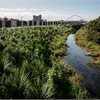What does 'drier' really mean in 'green' homes?
1 Aug 2025

Media release - Waipapa Taumata Rau, University of Auckland | Researchers say green-rating systems could improve clarity and effectiveness by explicitly defining ‘drier’ and using two measures of humidity.
As many New Zealanders contend with condensation, drafts, and mould this winter, a recent study challenges assumptions about what makes a home ‘drier’. It urges green building rating tools to clarify how humidity and dampness are measured and understood.
University of Auckland senior property lecturer Dr Mike Rehm, researcher Dr Rochelle Ade, and Dr V. Vishnupriya (Massey University) examined winter humidity levels in a 40-unit Auckland apartment building for residents aged 65 and older.
The building is 7-Homestar certified under New Zealand’s Green Building Rating System (v4), which promotes warmer, healthier, and drier homes, representing best practice for New Zealand housing.
The study found that relative humidity within the apartments often exceeded the recommended 40 to 60 percent range, which is commonly used to minimise condensation and mould risk.
However, the researchers stress that elevated relative humidity doesn’t necessarily mean the building is ‘damp’ or unhealthy. And when the same apartments were assessed using absolute humidity (a measure of the total moisture in the air) they consistently fell within the epidemiologically acceptable range for health and comfort.
“Humidity and dampness are often used interchangeably, but they are not the same,” says Rehm. “A building can have high relative humidity without being damp. That nuance is often lost, including in how certification tools like Homestar communicate ‘drier’ living conditions.”
The findings raise questions about which humidity metrics best reflect health and comfort, particularly in New Zealand’s naturally ventilated housing and humid coastal climates.
Despite relative humidity being outside the ideal range, most residents in the study reported feeling comfortable in their homes. The researchers suggest this may indicate that relative humidity alone may not reliably reflect health risks or occupant satisfaction, especially for older individuals.
The authors argue that green rating systems could improve clarity and effectiveness by explicitly defining ‘drier’ and considering both relative and absolute humidity.
“In cities like Auckland, where outdoor air is often humid, natural ventilation may not reduce relative humidity. But that doesn’t automatically mean a home is unhealthy or inefficient,” says Rehm. He proposes relative humidity be used as a primary performance metric, with absolute humidity included in some cases, to better reflect actual indoor conditions.
“Certification systems like Homestar already play an important role in improving New Zealand’s housing stock. Clarifying how vague, undefined terms like ‘drier’ are measured could enhance their effectiveness and help align performance goals with occupant wellbeing,” he says.
The paper, What is Drier? Understanding Humidity in Green-Certified Dwellings, is published in the Journal of the Royal Society of New Zealand and is part of a growing body of work calling for more precise, performance-based humidity guidelines in building standards.
print this story










